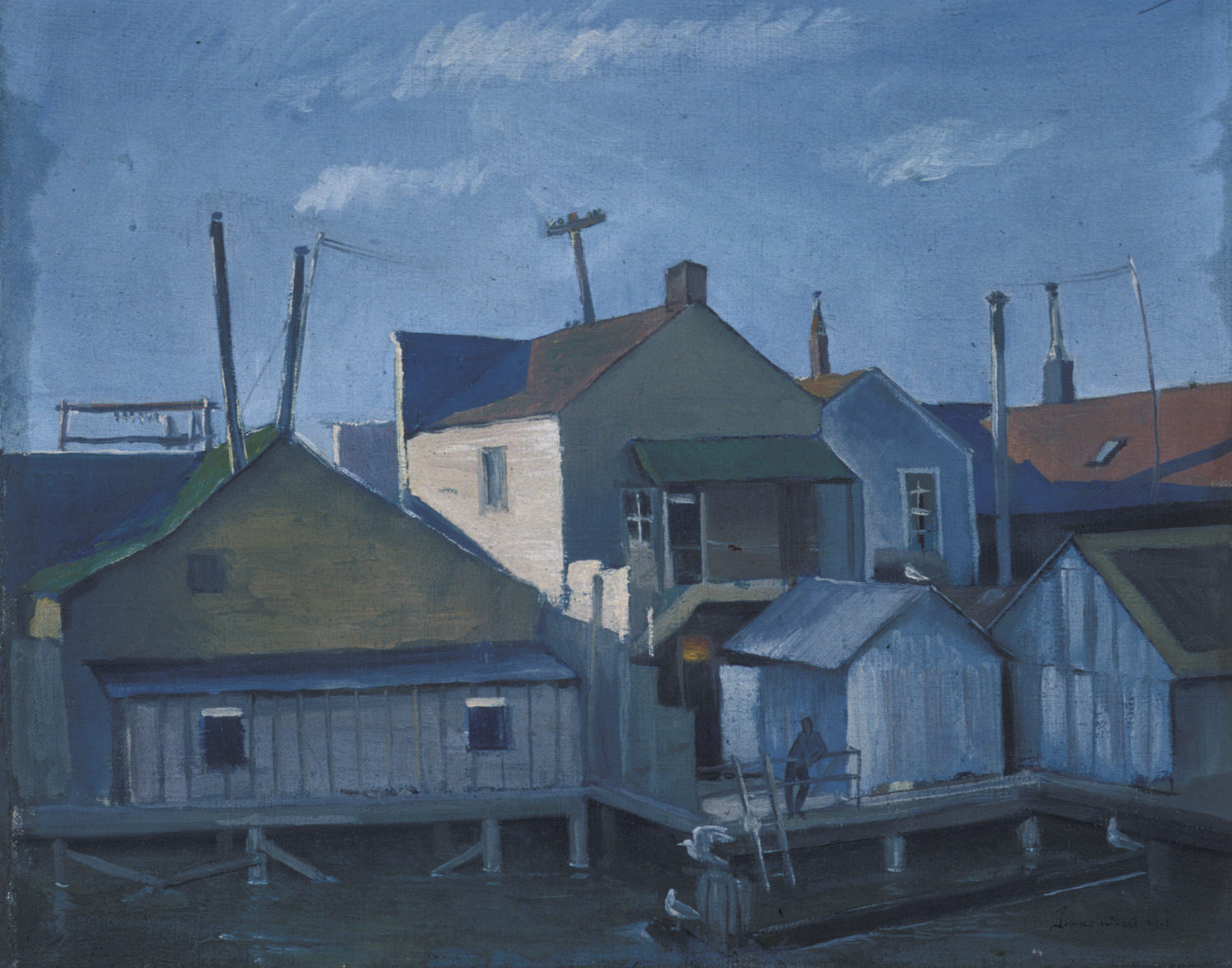
“Untitled” by Lance Hart
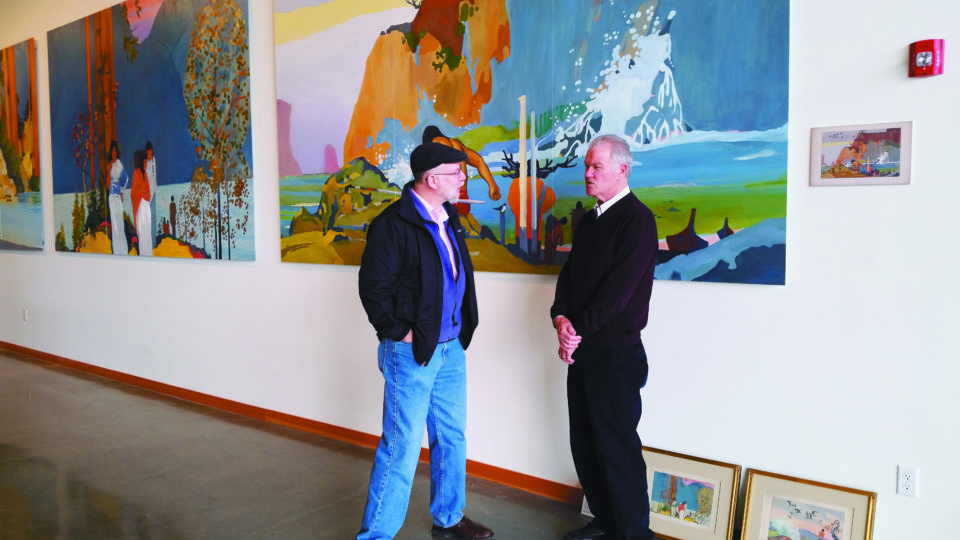
(Photo courtesy of Cascadia Museum) Erik Sandgren, left, and Cascadia Art Museum founder Lindsey Echelbarger, chat in front of a recreation of a mural originally painted by Lance Hart in the 1920s for the Moose Lodge in Aberdeen. Cascadia used Hart’s original studies when it commissioned the recreation.
I have been a painter of the Twin Harbors since 1989 when I first arrived in Aberdeen. In painting these landscape spaces I walked in the footsteps of other artists. My oils, watercolors, acrylics and drawings over the past quarter century range from the literal to the mythic — always with one eye to the Harbor itself and the other toward my predecessors. I have brought to these efforts a legacy of painting practice and knowledge that really began with my father, Nelson Sandgren’s, Depression-era education in the Art Department at the University of Oregon. His connection to an influential teacher there became even more clear to me a few months ago when a copy of “Cohassett Beach Chronicles” flew off the Timberland Library shelf and into my hands. By Kathy Hogan, as edited by Klancy Clark de Nevers and Lucy Hart, its wartime narratives of the Cohassett Beach community of Westport enlarged my notion of a coherent web of artistic effort centered on the south central coast of Washington over several generations.
Sometimes an artist can be literal and direct; at other times more sublimation and abstraction are required. Robert Motherwell and Lee Friedlander are the latter. Visual artists of substantial national reputations, they were born in Aberdeen and left to make their marks in international centers for art. And they are not alone.
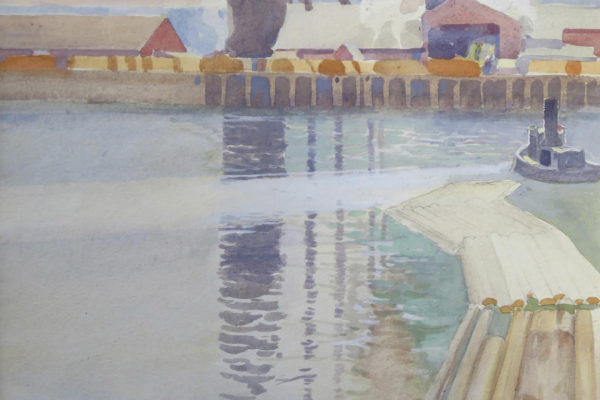
“Untitled” (mill at Aberdeen) by Lance Hart, circa 1916 (Courtesy of Martin-Zambito Fine Art)
To discern the Harbor in a work of art we can either recognize specific features or we can look beyond the familiar face of things. Sometimes the environmental influence is embedded in the form of the work. Nirvana’s variety of grunge is perhaps the very best example of a strong parallel between the place and a style. Very little of the lyrics or music is specifically about Aberdeen and yet some say that Aberdeen owns grunge. Similarly, we can consider the great American sculptor Alexander Calder. While not from the Northwest, he came out to visit his sister in Hoquiam and found summer work in local logging camps. For the rest of his life he produced innovative sculptures that mirror the high lines, engines, riveting, cables and thin linear connections between big shapes moving in space. To me his work belongs very much to Grays Harbor — the logging show as transformed and made essential through an artist’s imagination.
The photographs of Lee Friedlander, one of the most influential photographers of the past half century, are likewise compelling post-modern compositions. They are eccentrically composed in alienating environments — wry evocations of post-modern life that are compellingly bleak and beautiful at the same time. To me it is clear that they grow out of and evoke the industrial features of Harbor life. Robert Motherwell was also renowned on the national scene.
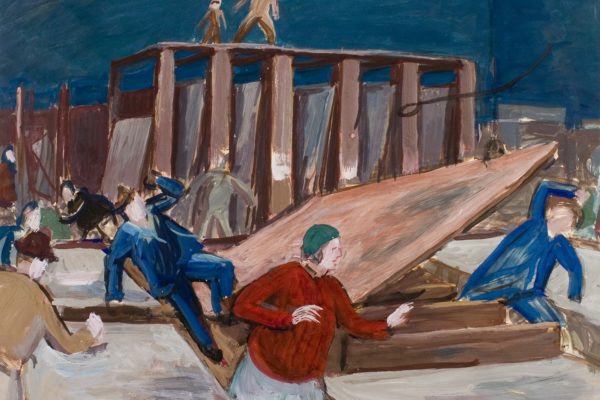
“When the Glomer Broke” by Arthur Runquist (Virginia Haseltine Collection of Pacific Northwest Art)
During and after the heyday of the New York School, many artists have retained a strong allegiance to the world of objects and spaces. Elton Bennett’s prints and my own paintings, for example, are composites of local and regional environments. Three other early-mid twentieth century painters of note were particularly inspired by this part of the world. These three painters are well represented in Northwest museums and private collections even though they are beneath the radar of the general public.Their nuanced color and striking compositions depict familiar surroundings. They have particularly inspired my efforts to paint here, and in so doing to craft poetry of the mundane.
Expanding the area of influence to Willapa Bay of the Twin Harbors, we find Albert Runquist (1894-1971) born in Aberdeen, and Arthur Runquist (1891-1971) born in South Bend. The Runquist brothers both grew up on the Twin Harbors then studied at the University of Oregon, the Art Student’s League in New York and at the Museum Art School in Portland. Albert was recognized sufficiently to be included in the Depression-era Works Progress Administration program to put artists to work and worked on a Sedro Woolley Post Office Project. They both labored in Vancouver’s Kaiser shipyards through World War II. They sought to memorialize both this Pacific Northwest landscape and the people who work in it and their representations of the working man, based on personal belief and experience, are interpretable as social criticism.
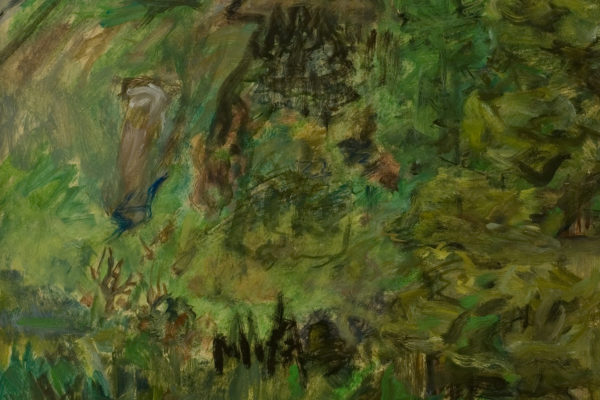
“Green Mountain” by Albert C. Runquest (Virginia Haseltine Collection of Pacific Northwest Art)
Their coastal landscapes are fully imbued with characteristic rain and clouds, oncoming storms, driftwood, snags, birds, wind, boats and men working in the elements — logging, fishing and clamming.
Of the landscape that has most inspired me, I have found nothing more inspiring than their loosely painted evocations. Later in their life they lived together and painted rather reclusively near Neahkanie Mountain in Oregon. Together, they developed a painterly approach of loose brushstrokes that seems timeless. Their later paintings are sometimes indistinguishable from each other. Observing everyday subjects, they applied pigment with a loose unaffected brushwork, a hallmark of style that completely avoids any form of commercial ambition, facility, grandiosity and polish.
Lance Wood Hart (1891-1941) was born in Lexington, Ky., and came to Aberdeen as a child at the death of his father. The family moved to be with his mill-owning uncle. In 1908 the Grays Harbor Post commended his “Exceptional skills and abilities.” Trained at the Chicago Art Institute and the Royal Academy of the Arts in Stockholm, he returned to the Harbor to make oil paintings. He developed a wonderful palette of warm color and suffused brightness that enlivened his coastal paintings. By 1931 he was assistant professor of drawing and painting at the University of Oregon. As it happens, my father, being a young painting student, took Hart’s composition course there. He used what he learned from Hart in many subsequent mural commissions. A treasured student exercise from Hart’s class manifests the same underlying geometries that animate Hart’s paintings — and the way in which his teaching is also effective and memorable.
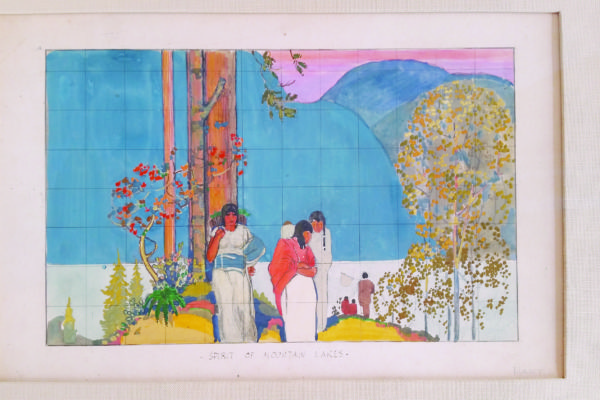
Study for mural at Aberdeen Moose Lodge, by Lance Hart, circa 1920 (Courtesy of Cascadia Museum Private Collection)
Hart’s Snohomish Post Office mural for the New Deal art program in 1940 is still viewable. It depicts heroic labor as the hope of the future. In the 1920s Hart had painted a large mural for the Aberdeen Moose Lodge. The only known photographic evidence of Lance Hart’s 1920 Aberdeen Moose Lodge mural can be found in the Jones Historical Photo Collection. Long lost, along with the building itself, its five, grand panels have been recreated to scale for the new Cascadia Art Museum in Edmonds. Lindsey Echelbarger, the museum’s founder, has custody of the small surviving watercolor sketches from which these huge mural panels were done.
Cohassett Beach in Westport offers a special nexus of artistic influence. Lance Hart had a cottage there and was the first serious inspiration for the young Robert Motherwell. Motherwell said of Hart, “He was the first artist I had ever met and was one of the loveliest men I ever met.” Describing summers at Cohasset Beach to an interviewer, Motherwell said, “… there were all these girls around and these fantastic beaches, isolation, this marvelous artist to talk to and who taught me how to play poker, and taught me how to make glug, which is a Scandinavian hot drink. So it was a kind of real beautiful holiday from the world.”
After his education at Stanford and Harvard, Motherwell was connected by Lance Hart to the University of Oregon for his first teaching gig. There Motherwell began to paint steadily for the first time. Hart was also close to David McCosh — another of my father’s mentors at the U of O in the late thirties. Eight years after Hart’s premature death in 1941, McCosh was welcomed by the Hart family to their cottage at Cohassett while on sabbatical leave from the U of O. It was then and there that he made the magnificent breakthrough in his work that became the hallmark of his mature style. A new fragmentation of planes and calligraphic line relate directly to the beach flotsam and driftwood at Cohassett. Lance’s daughter Lucy writes that “our father taught with David McCosh and yes, David took his sabbatical and stayed in our cottage at Cohassett Beach. How he survived the cold drippy winter there is a mystery.
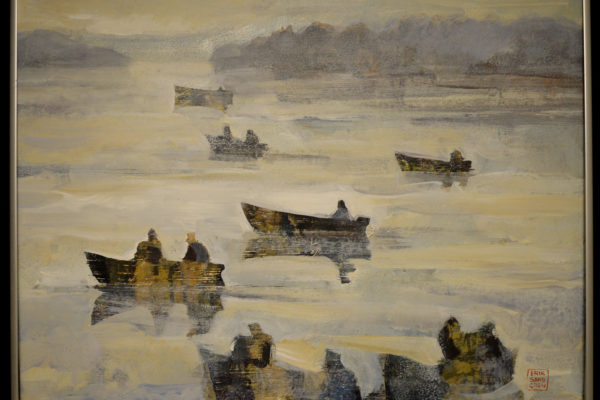
“Chehalis Salmon Boats” by Erik Sandgren 1999
The only heat in the cottage was from a living room fireplace and a wood stove in the kitchen. The cottage was not insulated so it must have been drafty and cold. There was a studio workspace in the house, perfect for an artist.” The weather must have been part of the inspiration because McCosh’s paintings from then on consistently differ in style from his large 1929 murals for the Department of the Interior in Washington, D.C., and the 1935 New Deal mural in the Kelso, Wash., post office.
Until the digital age, the art market mostly meant big cities. In the visual arts “regional” had become a dirty word — a label artists no longer wanted to be saddled with. Now, however, as with American roots music, we recognize fine visual art in nooks and crannies once thought to be remote. The work of all these artists is viewable in public collections. From naturalism to abstraction they offer us perspective on our place and time. Differences in style and approach can be tested against the continuities of the place itself. We may move on from the Twin Harbors with the insight that this special bit of coast has given shape to many an artist’s vision.